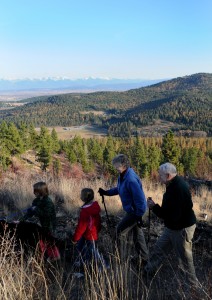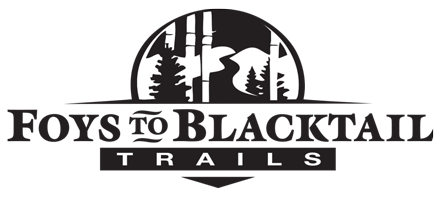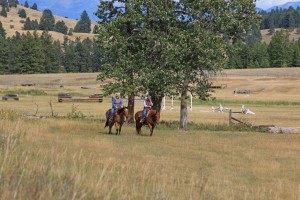December 2014–On December 17, FTBT closed on the final 60 acres in the 320-acre land acquisition effort, and transferred it to Flathead County Parks as an addition to Herron Park. Herron Park is now 440 acres large.
October 2014–On October 30, FTBT finished raising funds to add the final 60 acres to Herron Park, ending the $2.25 million campaign that began in 2007.
June 2014–Montana State Parks RTP Program notifies FTBT that it will receive $30,000 toward purchase of Phase 6.
April 2014–MT Fish & Wildlife Conservation Trust notifies FTBT that it will receive $40,000 toward purchase of Phase 6.
March 2014–The Flathead County Parks Board, with approval of the County Commissioners, notifies FTBT that it will receive $20,000 toward Phase 6 land purchase from the county’s Cash in Lieu fund.
July 2013 – FTBT completes Phases 4 & 5: Purchase of 110 acres of the The Conservation Fund property, with simultaneous transfer to Flathead County Parks as an addition to Herron Park.
April 2013 – FTBT transfers Phase 3 land to Herron Park.
September 2012 – U.S. Forest Service announces award of a $400,000 Community Forest Grant to Flathead County to assist with land purchase to expand Herron Park and create a community forest.
July 2012 – FTBT completes Phase 3: Purchase of another 50 acres of The Conservation Fund property.
November 2011 – FTBT completes Phase 2: Purchase of another 60 acres of The Conservation Fund property. FTBT donates this 60 acres to Flathead County as an addition to Herron Park.
May 2011 – Montana Conservation Corps and FTBT volunteers complete The Notch Trail, just in time for the Herron Hustle.
December 2010 – FTBT completes Phase 1: Purchase of the first 40 acres of the The Conservation Fund property. FTBT donates this 40 acres to Flathead County as an addition to Herron Park.
Summer/Fall 2010 FTBT’s electronic trail use counter confirms our casual observations: More people than ever are using The Conservation Fund property that FTBT is raising funds to purchase and add to Herron Park.
April 2010 Thanks to a Recreational Trails Program grant, FTBT and Montana Conservation Corps build new trails in Herron Park. These include the Family Trail, Direct Route, Horse Trail, and more.
April 2010 The Flathead County Parks Board, with approval of the County Commissioners, notifies FTBT that it will receive $62,500 for land purchase from the county’s Cash in Lieu fund.
March 2010 The Canyon Ferry Trust, administered by Montana Fish, Wildlife and Parks, grants $40,000 to FTBT to be used for purchase of The Conservation Fund land.
February 2010 Thanks to a grant from the Sustainability Fund, FTBT hired its first staff member, Jill Seigmund, a part-time administrative assistant.
December 2009 Foy’s to Blacktail Trails Inc. (FTBT) is notified that it will receive a $70,000 Recreational Trails Program (RTP) grant, administered by the State of Montana. Funds are to be used to help purchase the first 40-acre parcel of the 320-acre Conservation Fund property. Once purchased, FTBT will add it to Herron Park so that the public will enjoy permanent access to this property.
November 2009 Flathead County Commissioners sign agreement to accept The Conservation Fund land and manage it as part of Herron Park if FTBT is successful in its attempt to purchase this property.
October 2009 FTBT’s Trails Committee completes a proposed Master Trails Plan that will integrate existing and proposed trails for The Conservation Fund property and county-owned Herron Park.
June 2009 In partnership with Montana Conservation Corps (MCC), FTBT improved the tread over the length of the Plum Creek Connector, Foy’s Overlook, and Chase Family Forest trails.

Family Fun at the Foy’s Overlook.
February 2009 The Conservation Fund extends deadline to September 2012 for purchase of the 320-acre parcel, allowing time for FTBT to develop and execute a formal capital campaign.
Summer 2008 Montana Conservation Corps works with FTBT to build the Overlook Trail, allowing users to easily gain access to the top of the ridge overlooking Foy’s Lake and the Flathead and Smith Valleys.
Spring 2008 FTBT Secured a commitment from Flathead County to own any permanent trail easements that can be established on private land in the Foy’s to Blacktail area of interest.
Fall 2007 FTBT arranged for The Conservation Fund to bridge buy the 320-acre parcel above Herron Park to prevent it from being sold and closed to the public. Conservation Fund initially allows 2 years to raise the $2.3 million (including interest and expenses) needed to purchase the property. Though private property, this parcel is used heavily by the public , and is the gateway to forested lands extending south to Blacktail Mountain.
Summer 2007 Secured a permit from Plum Creek Timber and built a “connector trail” from the 320-acre parcel to the Chase Family Forest property; also built trail on the Chase Family Forest property.
Spring 2007 Secured a permanent trail easement from John and Myron Chase on the 160 acre Chase Family Forest property.
2006 John and Myron Chase donate a permanent conservation easement on their 160-acre property to the Montana Land Reliance. Their grandfather homesteaded in this property in 1910.
2005 Foy’s to Blacktail Trails Inc. receives 501(c) (3) non-profit status from the IRS (FTBT had been temporarily operating under the umbrella of the Flathead Land Trust).
2001 Trail enthusiasts begin meeting to discuss ways to protect public access to the lands extending south from Herron Park to Blacktail Mountain. Early name for this group is the Birch Creek Trail Project. Later, they rename the group Foy’s to Blacktail Trails.
1978 Flathead Combined Training Association (FCTA) approaches Flathead County Parks requesting that they allow FCTA to make improvements to the park (cleanup, running electricity, building stables, arenas and more) creating an attractive equestrian facility suitable for three day eventing. Flathead County Parks approves and FCTA begins to significantly improve Herron Park.
1977 Flathead County obtains 120 acres of Iven Herron’s grazing/timber property for use as a public park. (Part of the land was donated, part purchased). Later named Iven C. Herron Memorial Park, it is at that time by far the county’s largest park.
1883 John Moroni Foy enters the Flathead Valley with his wife and eight children via wagon train. The following year he files a homestead on the north end of an unnamed lake west of the settlement of Ashley (now Kalispell). He starts a successful sawmill operation on the lake that soon becomes known as Foy’s Lake. When the settlement of Demersville springs up, its residents turn to Foy for lumber to construct homes, stores and saloons.

